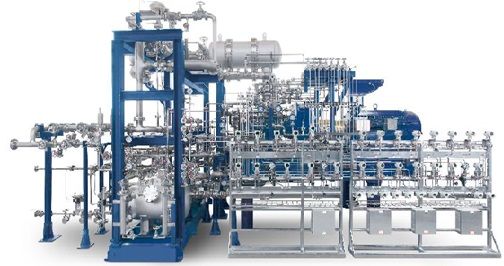How screw compressor scores over recip, centrifugal in flare gas
Flare gas recovery is a growing application due to the increasing desire to recover all energy sources, as well as increasing restrictions on emissions and flaring. The challenge for a flare gas compressor is to be able to handle varying molecular weights and inlet pressures as the makeup and supply of flare gas changes over time. This is one of the strong areas for a screw compressor – the positive displacement principle means that it is generally insensitive to changing inlet conditions, and the robust nature of the stiff rotor design combined with few moving parts makes it well able to handle occasional upset conditions.

Two stage oil free screw compressor system for flare gas recovery[/caption]
This article contains excerpts from the paper, "Your Gas Compression Application – Reciprocating, Centrifugal, or Screw?" presented at the 2016 Turbomachinery Symposium by Greg Phillippi of Ariel Corporation, Tim Manthey of Aerzen USA, Jonathan Sutter of Elliott Group, Ben Williams of Ariel Corporation, Bruce McCain, an engineering consultant.
Here are the operating conditions:
Flare Gas MW – 20.0
K, ratio of specific heats – 1.3
Suction pressure (psia) – 14.7
Suction temperature (°F) – 175
Capacity (SCFM) – 450
Discharge Pressure (psia) – 130
With the screw compressor it is interesting to note that if the mole weight of the flare gas varies between 10 and 30, as long as the volumetric flow rate remains constant, the brake horsepower also remains nearly constant. Flare gas applications often need to maintain either a constant inlet pressure to support the upstream system or a constant discharge pressure to the downstream users.
A screw compressor is well suited to either case. For an oil-flooded screw compressor, an internal slide valve can be used for capacity control without varying the operating speed.
Oil-free screw compressors are also used in this service, and in these cases a VFD or recycle line are used for capacity control. If an oil-flooded screw compressor is used in this application, the oil will be in contact with the gas, and thus must be selected based on compatibility with the gas components.
Oil-free screw compressors are less susceptible to issues related to gas composition, and as long as the gas is above the dew point (as is true most of the time with oil-free screw compressors), there is little risk to the materials of the compressor.
Reciprocating Compressor - Impractical.
The challenge for a reciprocating compressor in this application is the varied molecular weight of the gas. Although reciprocating compressors can compress a wide variety of gas molecular weights, in order to achieve the reliability required in the process industry, the compressor valves are configured based on the operating conditions and the gas molecular weight.
Since the gas composition varies in flare gas service, it can be difficult to configure the valves to meet the entire range. The valves are never “optimized”.
In cases where reciprocating compressors are used in flare gas service, the valves are typically configured with low lifts to reduce the valve impact velocity, which can help improve valve life.
Centrifugal Compressor – Impractical
In considering the use of a centrifugal compressor for this application, the first problematic attribute is the low flow rate of 550 ACFM. Due to the size of the flow passages in the centrifugal compressor the efficiency will suffer. Secondly, the ratio of specific heats, K, coupled with the lower efficiency will require at least one intercooler. Although there are centrifugal compressors that accommodate connections for up to two process-intercoolers on a single casing, the number of impellers required to reach the final discharge pressure at the lower mole weight of 10 will require multiple compressor bodies (due to rotor dynamics). Finally, there is the large mole weight variation between the operating cases.
In theory, a recycle loop could be added after the process-intercooler (every four to six impellers) which would allow recycle flow to be added to each section of compression, thereby counter acting the effect of volume ratio mismatch, however the overall system efficiency and amount of equipment (multiple compressors and an intercooler) would quickly lead one to investigate another type of compressor.